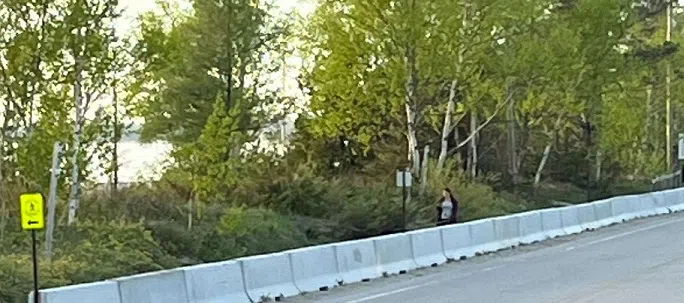Plans to cut into the dunes at Sauble Beach to regain parking spaces are on hold for a moment as the newly elected Town council considers its options.
It was the first meeting of this South Bruce Peninsula council since their election October 24th, with new mayor Garry Michi, new councillor Caleb Hull, and returning Deputy Mayor Jay Kirkland as well as returning councillors Kathy Durst and Terry Bell.
During the meeting, staff gave a report and looked to council for direction on what should, or should not be done with regard to the sand dunes encroaching on parking spaces in the downtown area of Sauble Beach from the Crowd Inn to roughly Kinloss Lane.
After some discussion, council passed a motion requesting staff bring back more information about removing the current jersey barrier but also addressing ways to test the sand for contamination, as there is interest among councillors to redistribute any moved sand back onto the beach if environmental regulations permit it.
In recent years, the previous council had been planning to cut into the dunes by several feet to where existing bollards once marked the edge of the dunes to regain space that had once existed for parking but has since been covered by migrating sand. The plan was to construct a retaining wall in the belief it would keep sand from blowing off the beach.
A permit for the planned work had been initially granted by the Grey Sauble Conservation Authority, but that plan was met with disapproval from some area residents including Saugeen Ojibway Nation, Friends of Sauble Beach, and Ecojustice among others.
In November 2020, the Saugeen Ojibway Nation Environment Office also sent a letter to the Town of South Bruce Peninsula, saying it had concerns with work being done on the land, noting, “The location in question (the waterfront along the shore of Lake Huron including from Lot 25 to the middle of Lot 31), is and always has been part of Saugeen First Nation Indian Reserve #29.”
That December, a protest with about 50 people was held on the day work had been slated to begin.
Meanwhile, a resident filed a judicial review of the GSCA permit, which was eventually revoked by a court in the summer of 2021. In its reasons, the court said the conservation authority didn’t apply the relevant tests and that it had no regard for the issue of whether the project was consistent with a prohibition in the 2020 Provincial Policy Statement on the development of dynamic beach hazards.
A report from Town CAO Bill Jones Tuesday says, in February 2022, staff submitted a more robust application to the Conservation Authority and has since been working with the Ministry of the Environment, Conservation and Parks as well as the conservation authority, to supply them with more information in support of their application.
Jones says staff paused work on the project during the election period to give this new term of council time to discuss it.
Some of that discussion took place Tuesday, with councillors considering a number of options presented by staff:
The initial plan was to cut into the dunes and build a three-foot retaining wall to regain angle parking spaces and provide room for pedestrians to safely walk behind those parked cars without having to walk in traffic.
Staff also presented three alternative options Tuesday.
One would be to use sheet piles as a retaining wall, which staff say would reduce impacts on the dunes, as well as the amount of sand to be removed. Staff note this option is expected to cost double the overall estimated project cost. They also say there is no guarantee it will be enough to obtain the necessary approvals.
Another option would be to simply remove the sand back to the bollards that once marked the edge of the dunes. It would involve a shallower cut in the dunes than if a retaining wall were to be built.
Another option staff put to council was to go back to the beginning of the process and do an Environmental Assessment process that would define the issue the Town is trying to address, as well as give opportunity for consultations to consider social, economic, safety and environmental impacts.
Staff say that would take about a year to complete and could cost over $100,000 for engineers, environmental consultants and studies. They also note, “Although this process is inclusionary, there is still no guarantee that everyone will be supportive of the preferred alternative that comes from the process.” They say this process would also mean those affected parking spaces would remain closed in 2023.
Councillor Terry Bell emphasized the need for pedestrian safety.
Councillor Caleb Hull suggested the short-term solution should be to remove the jersey barrier and consider parallel parking as a strategy going forward. He says there should be a re-vegetation plan and implementation of other measures like snow fencing could be considered to keep the sand on the beach.
Deputy Mayor Jay Kirkland maintained in the discussion, he believes the sand will drift off the beach regardless of what measures are taken, and advocated for the idea of redistributing the sand from the parking area, back onto the beach, saying the idea of removing the sand has always bothered him. But he says there is a requirement to show the sand is not contaminated.
CAO Bill Jones replied it’s likely the sand that is in the area of the bollards would be deemed ‘safe’ to redistribute, and the sand that has drifted into the parking area may be deemed ‘unsafe’ because of petroleum and fuel leakage onto it by cars.
Kirkland noted it’s only recently people stopped driving and parking on the beach as a regular occurrence and asked what makes the sand on the beach now considered to not be contaminated. He also noted parking on the street side of the dune still has the potential to contaminate the beach if water migrates towards the lake.
Councillor Kathy Durst noted whatever solution council decides on, it should be a long-term one.
Mayor Garry Michi agreed, he’d like to know more about how regulators decide that’s contaminated.
A motion was passed that said council directs staff to, “provide a report regarding alternatives to the temporary jersey barrier wall until such time as a permanent solution is approved that addresses the currently closed parking area, and further that staff provide a report that provides information regarding the process and cost of sampling sand to confirm it is not contaminated and be placed on the beach.”
Staff will come back to the next meeting with a report containing that information for council to consider.



